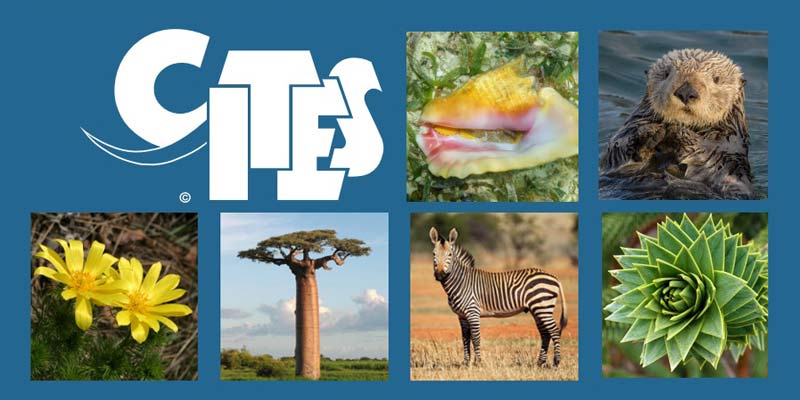- India
- Nov 25
Explainer / What is CITES?
India’s proposal for enhancing protection status to Leith’s Softshell Turtle has been adopted at the ongoing world wildlife conference in Panama, the Union environment ministry said.
The country also proposed to give a higher degree of protection to the Red-Crowned Roofed Turtle or ‘Batagur Kachuga’ and received wide support from other parties at the 19th meeting of the Conference of Parties (CoP 19) to the Convention on International Trade in Endangered Species of Wild Fauna and Flora (CITES) being held in Panama City.
What is CITES?
• The Convention on International Trade in Endangered Species of Wild Fauna and Flora, known as CITES or the Washington Convention, was signed on March 3, 1973 and entered into force on July 1, 1975.
• With 184 Parties (183 countries and the European Union), it remains one of the world’s most powerful tools for wildlife conservation through the regulation of international trade in over 36,000 species of wild animals and plants.
• Annually, international wildlife trade is estimated to be worth billions of dollars and to include hundreds of millions of plant and animal specimens. The trade is diverse, ranging from live animals and plants to a vast array of wildlife products derived from them, including food products, exotic leather goods, wooden musical instruments, timber, tourist curios and medicines.
• Levels of exploitation of some animal and plant species are high and the trade in them, together with other factors, such as habitat loss, is capable of heavily depleting their populations and even bringing some species close to extinction.
• Many wildlife species in trade are not endangered, but the existence of an agreement to ensure the sustainability of the trade is important in order to safeguard these resources for the future.
• CITES seeks to ensure that international trade in such species is sustainable, legal and traceable and contributes to both the livelihoods of the communities that live closest to them and to national economies for a healthy planet and the prosperity of the people in support of UN Sustainable Development Goals.
• CITES regulates international trade in specimens of species of wild fauna and flora based on a system of permits and certificates issued under certain conditions.
• It covers export, re-export, import and landing from the high seas of live and dead animals and plants and their parts and derivatives.
• The CITES Secretariat is administered by United Nations Environment Programme (UNEP) and is located at Geneva, Switzerland.
How CITES works?
• CITES works by subjecting international trade in specimens of selected species to certain controls.
• All import, export, re-export and introduction from the sea of species covered by the Convention has to be authorised through a licensing system.
• Each Party to the Convention must designate one or more management authorities in charge of administering that licensing system and one or more scientific authorities to advise them on the effects of trade on the status of the species.
• The species covered by CITES are listed in three Appendices, according to the degree of protection they need.
i) Appendix I includes species threatened with extinction. Trade in specimens of these species is permitted only in exceptional circumstances.
ii) Appendix II includes species not necessarily threatened with extinction, but in which trade must be controlled in order to avoid utilisation incompatible with their survival.
iii) Appendix III contains species that are protected in at least one country, which has asked other CITES Parties for assistance in controlling the trade. International trade in specimens of species listed in this Appendix is allowed only on presentation of the appropriate permits or certificates.
• Species may be added to or removed from Appendix I and II, or moved between them, only by the Conference of the Parties (CoP).
• At each regular meeting of the CoP, Parties submit proposals based on those criteria to amend these two Appendices I and II. Those amendment proposals are discussed and then submitted to a vote.
• Changes to Appendix III follow a distinct procedure from changes to Appendices I and II, as each Party is entitled to make unilateral amendments to it.
Proposal for enhance protection to Leith’s Softshell Turtle
• The transfer of Leith’s Softshell Turtle from CITES Appendix II to Appendix I would ensure that legal international trade in the species does not take place for commercial purposes.
• It would also ensure that international trade in captive-bred specimens only takes place from registered facilities and that higher and more proportionate penalties are provided for illegal trade of the species.
• Leith’s Softshell Turtle is a large freshwater soft-shelled turtle which inhabits rivers and reservoirs. It is endemic to peninsular India.
• The species has been subject to intensive exploitation over the past 30 years. It has been poached and illegally consumed within India. It has also been illegally traded abroad for meat and for its calipee.
• The population of this turtle species is estimated to have declined by 90 per cent over the past 30 years and the species is now difficult to find. It is classified as “critically endangered” by the International Union for Conservation of Nature (IUCN).
• The species is listed on Schedule IV of the Wild Life (Protection) Act, 1972, which gives it protection from hunting and trade. However, poaching and illegal trade of protected turtle species is a major challenge in India with seizures of thousands of specimens reported every year.
• Species level identification of the seized specimens is also a challenge. Tortoises and freshwater turtles are targeted for the international pet, meat and calipee trade, as well as for illegal domestic consumption in some areas.
• India’s proposal for uplifting of Batagur Kachuga from Appendix II to Appendix I of CITES received overwhelming support and was recommended for adoption with consensus.
Manorama Yearbook app is now available on Google Play Store and iOS App Store

